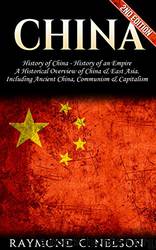China: History of China - History of an Empire: A Historical Overview of China, & East Asia. Including: Ancient China, Communism, & Capitalism by Raymond C. Nelson

Author:Raymond C. Nelson [Nelson, Raymond C.]
Language: eng
Format: epub
Tags: History, Asia, China, 90 Minutes (44-64 Pages)
Amazon: B01L3UUQJK
Publisher: Raymond C. Nelson
Published: 2016-08-26T00:00:00+00:00
Chapter 7 – History of Chinese Language
The Chinese writing system is one of its kind. It is unique because it doesn’t follow the normal alphabetic scripts like the majority of the languages. It is a phenomenon which has evolved over time with the usage of characters and complex signs which represent words and morphemes. While there are other languages extant which use pictures or characters in the written system (Logography), Chinese is the only language which serves as the basic language of hundreds of millions of people.
Japanese and Korean writing systems are related to the Chinese writing systems, but they can purely function as phonetic scripts. While the first recognizable Chinese writing script is said to be 3500 years old, its origin goes back even further in history. Keeping the debate on its origin on one side, Chinese language has evolved over time while keeping its core from antiquity. This makes that Chinese has been used continuously throughout history for one of the longest times in the world.
Origin and Evolution
The common consensus among historians is that the Chinese writing system evolved from the non-linguistic symbols. During the latter half of 3rd millennium BCE (Late Neolithic period), many symbols or pictograms were incised on pottery and jades; these are thought to be family emblems of a particular culture or dynasty, which proved their ownership. Some of these emblems were used as the name of a Dynasty on artifacts. It is believed that at some point, the symbols ceased to represent the picture on it and acquired the status of a word. It is unclear exactly when this switch took place, but it is agreed upon that the words currently in use evolved from the symbolic language. It is possible that these symbols might have been used as words even at that time, but there is no clear evidence to prove such claim.
Although the initial phase remained largely obscure, Chinese language had gathered a lot of symbols, and it had become quite intricate during the Shang dynasty. Oracle bone script is the earliest form of Chinese writing used from 1500 – 1000 BCE. After etching the symbols on turtle shells and animal bones, it was allowed to heat, and interpretations were made after the appearance of cracks. Traces are found where this system was used in courts.
Some Complexities
A common feature in the earlier writing phase is the use of ‘rebus writing.’ Rebus writing means to use a symbol representing a word for another word with a similar sound but different meaning. An example from English would make things clearer. The symbol ‘4’ actually means four, but it is used to represent the word ‘for’. Chinese is more of a monosyllabic language which means that rebus writing was used quite frequently.
A complexity which surrounded the early Chinese script was the use of the same sign for two or more words with relatively similar meaning, but entirely different sounds (polysemy). For example, the sign used for the words “eye” (*muk) and “to see” (*kens) was the same.
Download
This site does not store any files on its server. We only index and link to content provided by other sites. Please contact the content providers to delete copyright contents if any and email us, we'll remove relevant links or contents immediately.
| Africa | Americas |
| Arctic & Antarctica | Asia |
| Australia & Oceania | Europe |
| Middle East | Russia |
| United States | World |
| Ancient Civilizations | Military |
| Historical Study & Educational Resources |
The Sympathizer by Viet Thanh Nguyen(4284)
The Rape of Nanking by Iris Chang(4120)
World without end by Ken Follett(3410)
Ants Among Elephants by Sujatha Gidla(3390)
Blood and Sand by Alex Von Tunzelmann(3113)
Japanese Design by Patricia J. Graham(3089)
City of Djinns: a year in Delhi by William Dalrymple(2493)
The Queen of Nothing by Holly Black(2459)
Foreign Devils on the Silk Road: The Search for the Lost Treasures of Central Asia by Peter Hopkirk(2418)
India's Ancient Past by R.S. Sharma(2393)
Inglorious Empire by Shashi Tharoor(2383)
Tokyo by Rob Goss(2367)
In Order to Live: A North Korean Girl's Journey to Freedom by Yeonmi Park(2325)
Tokyo Geek's Guide: Manga, Anime, Gaming, Cosplay, Toys, Idols & More - The Ultimate Guide to Japan's Otaku Culture by Simone Gianni(2301)
India's biggest cover-up by Dhar Anuj(2298)
The Great Game: On Secret Service in High Asia by Peter Hopkirk(2285)
Goodbye Madame Butterfly(2187)
Batik by Rudolf Smend(2093)
Living Silence in Burma by Christina Fink(2023)
